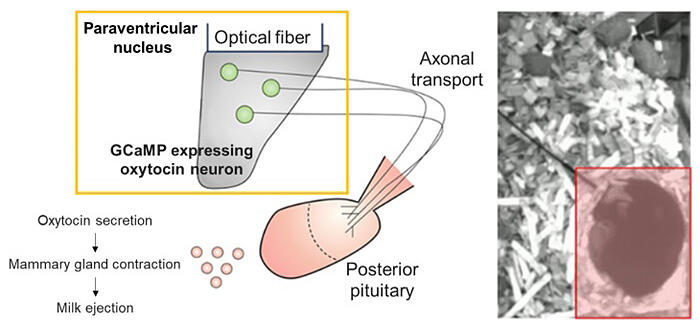A joint research team led by Graduate Student Kasane Yaguchi and Team Leader Kazunari Miyamichi of the Laboratory for Comparative Connectomics at the RIKEN Center for Biosystems Dynamics Research investigated the neuronal cells that produce the hormone oxytocin, a key compound that controls the breastfeeding behavior of mother mice. The researchers developed an experimental system to easily visualize the activity of cells (oxytocin neurons) in wild-type mother mice and found that the frequency of activity fluctuated during the lactation period.
The ability to detect the activity of oxytocin neurons without the need for complicated mating of genetically modified mice has greatly reduced experimental costs. The findings are also important in clarifying the neural mechanisms that control breastfeeding and are expected to develop into foundational knowledge that contribute to medical obstetrics and gynecology. The results were published in the academic journal PLOS ONE.

Provided by RIKEN
Oxytocin is essential for milk ejection as it mediates the contraction of the mammary glands. During breast-feeding, oxytocin neurons show wave-like (pulse-like) activity every few minutes and secrete a large amount of oxytocin into the blood; however, the specific mechanism of this process remains unclear. In 2022, Miyamichi and his colleagues succeeded in capturing the activity of oxytocin neurons of lactating mice; however, the experiment required complicated manipulations such as crossing genetically modified mice.
The research team previously developed a viral vector that incorporated the genomic sequence that regulates gene transcription, which was located 2.6 kilobase pair upstream of the mouse oxytocin gene and succeeded in expressing specifically targeted foreign genes in oxytocin neurons located in the paraventricular nucleus.
In the present study, the research team used this viral vector to specifically express a calcium ion sensor protein, GCaMP, in oxytocin neurons of wild-type mice. These female mice mated and gave birth. The research team then observed the activity of the oxytocin neurons during lactation. The activity data were comparable to those obtained in previous studies using complex genetically modified animals.
With this new experimental system, the research team first examined the effects of short-term weaning on the activity of maternal oxytocin neurons 12-14 days after giving birth (middle lactation). They isolated the baby mice with a wire mesh and observed the oxytocin neurons of the mother mouse when the papillae could not be nursed from.
Under wire mesh isolation, the mother mouse recognized the appearance, cries, and smell of the baby mice and searched around the wire mesh; however, the pulse-like activity of oxytocin neurons was completely absent during the isolation period. In humans, nursing mothers lactate just by hearing their baby's voices or looking at their pictures. However, in mice, the milk ejection reflex does not seem to occur without nursing stimulation to the nipples.
When the mother mouse was allowed to breastfeed again directly, the pulsatile activity of oxytocin neurons immediately resumed, with a significantly increased number of occurrences compared to before isolation. These observations demonstrated the plasticity in neural activity during the milk ejection reflex, and that "rebound" occurs after a temporary weaning due to mother-infant isolation.
The group subsequently investigated the activity dynamics of oxytocin neurons during the late lactation period, which has been rarely reported. Data were recorded three times after birth; namely, at 2−4 days (early lactation), 12−14 days (middle lactation), and 18 days (late lactation), with a 6-hour light/dark period each. Concurrently, the mouse cage was video recorded, and the time spent by the mother mouse in the nest was measured. Video analysis revealed that pulsatile activity of oxytocin neurons occurred only when a mother mouse was in the nest and crouched over her offspring. Moreover, the residence time of the mother mouse was constant throughout the lactation period in the light period but decreased with the progression of the lactation period in the active dark period. The number of neural pulses per six hours did not change during both light and dark periods throughout the lactation period. Consequently, when the mother mouse was in the nest, the number of pulsatile oxytocin-neuron actions generated per hour increased significantly during the middle and late stages of lactation.
Moreover, a closer look at the development of the pulse-like activity of oxytocin neurons revealed a clustering phenomenon as the lactation period progressed. To analyze this result in detail, the research team quantitatively examined the interval between pulse-like activities (IPI). The results revealed that the ratio of short IPI in both the light and dark periods increased significantly as the lactation period progressed and that the clustering became more pronounced (the pulse generation became more continuous). The IPI distribution within the well-clustered late lactation was similar to the computer-simulated exponential distribution that assumed random pulse generation. These findings suggest that oxytocin neurons possess a mechanism to generate random pulses autonomously.
Journal Information
Publication: PLOS ONE
Title: Dynamic modulation of pulsatile activities of oxytocin neurons in lactating wild-type mice
DOI: 10.1371/journal.pone.0285589
This article has been translated by JST with permission from The Science News Ltd. (https://sci-news.co.jp/). Unauthorized reproduction of the article and photographs is prohibited.




